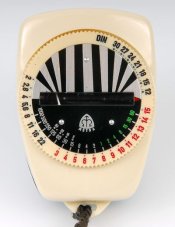openbinary
Member
I recently received a very old light meter and I have no idea how it works. It took me a while to find out the make/model but I can't seem to find anywhere instructions on how I can use it. APUG is my last hope 
The light meter is called Exposimet and it was made by the Czech company Metra. Here's a picture of it:

I've never used a light meter before but I assume that based on the input of 2 values and you find out the third e.g. you set ISO(marked DIN on the device) and Aperture and you find out the exposure time.
The device is completely solid and the only moveable parts are the exterior ring (which contains the ISO values and Aperture as well as a series of numbers from 3 to 15) and the needle of the meter. There's a red arrow on the body pointing to the ring which indicates either a result or an input value.
Does anyone have any idea on how to correlate the values? Any help is greatly appreciated.
Thanks!

The light meter is called Exposimet and it was made by the Czech company Metra. Here's a picture of it:

I've never used a light meter before but I assume that based on the input of 2 values and you find out the third e.g. you set ISO(marked DIN on the device) and Aperture and you find out the exposure time.
The device is completely solid and the only moveable parts are the exterior ring (which contains the ISO values and Aperture as well as a series of numbers from 3 to 15) and the needle of the meter. There's a red arrow on the body pointing to the ring which indicates either a result or an input value.
Does anyone have any idea on how to correlate the values? Any help is greatly appreciated.
Thanks!










